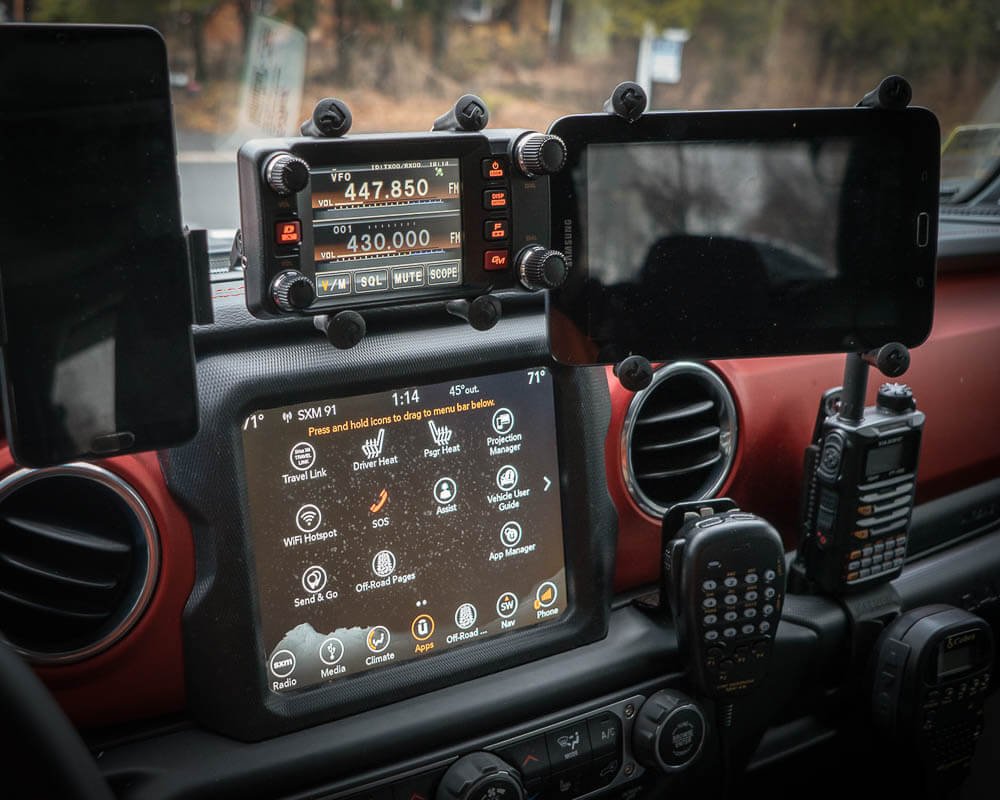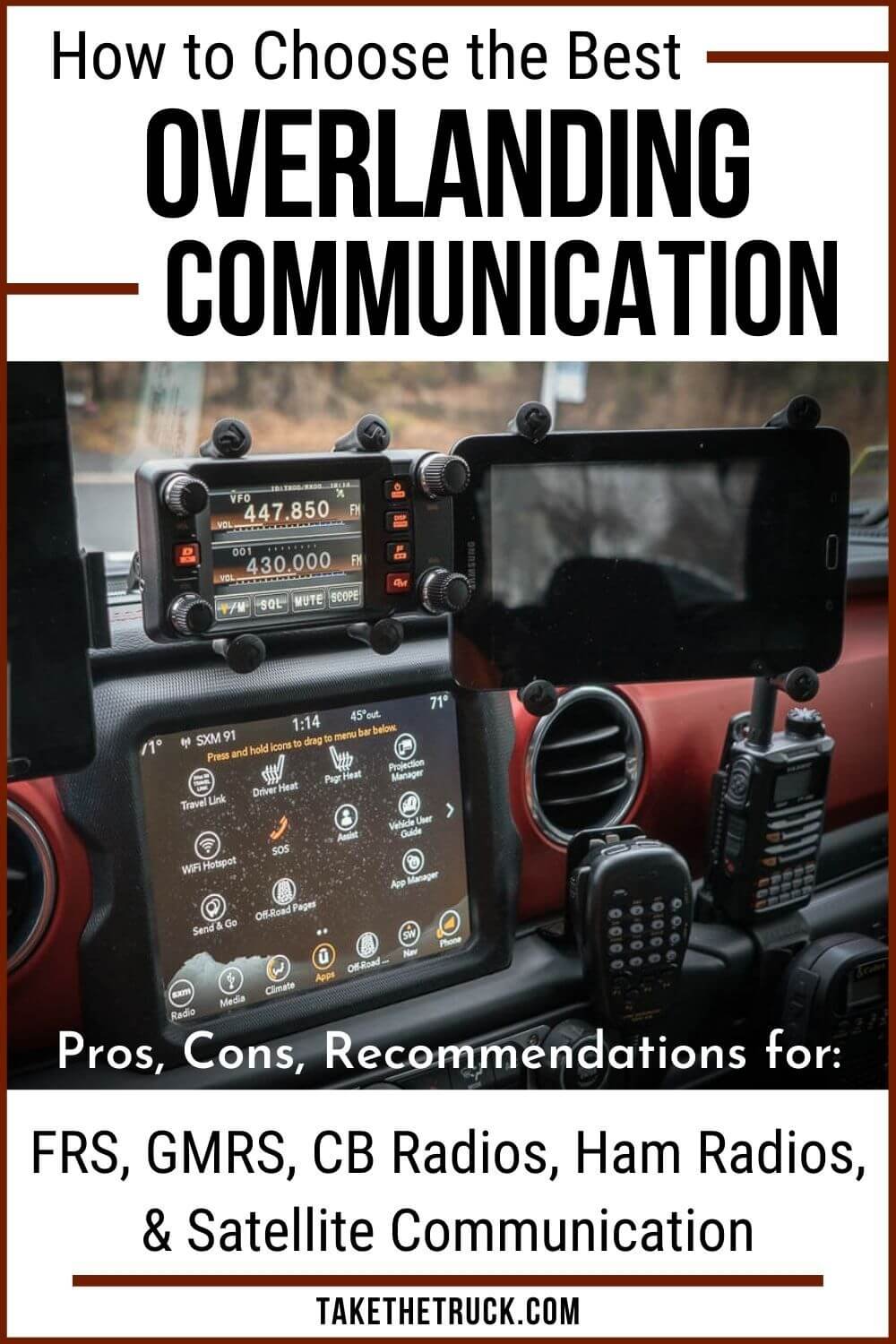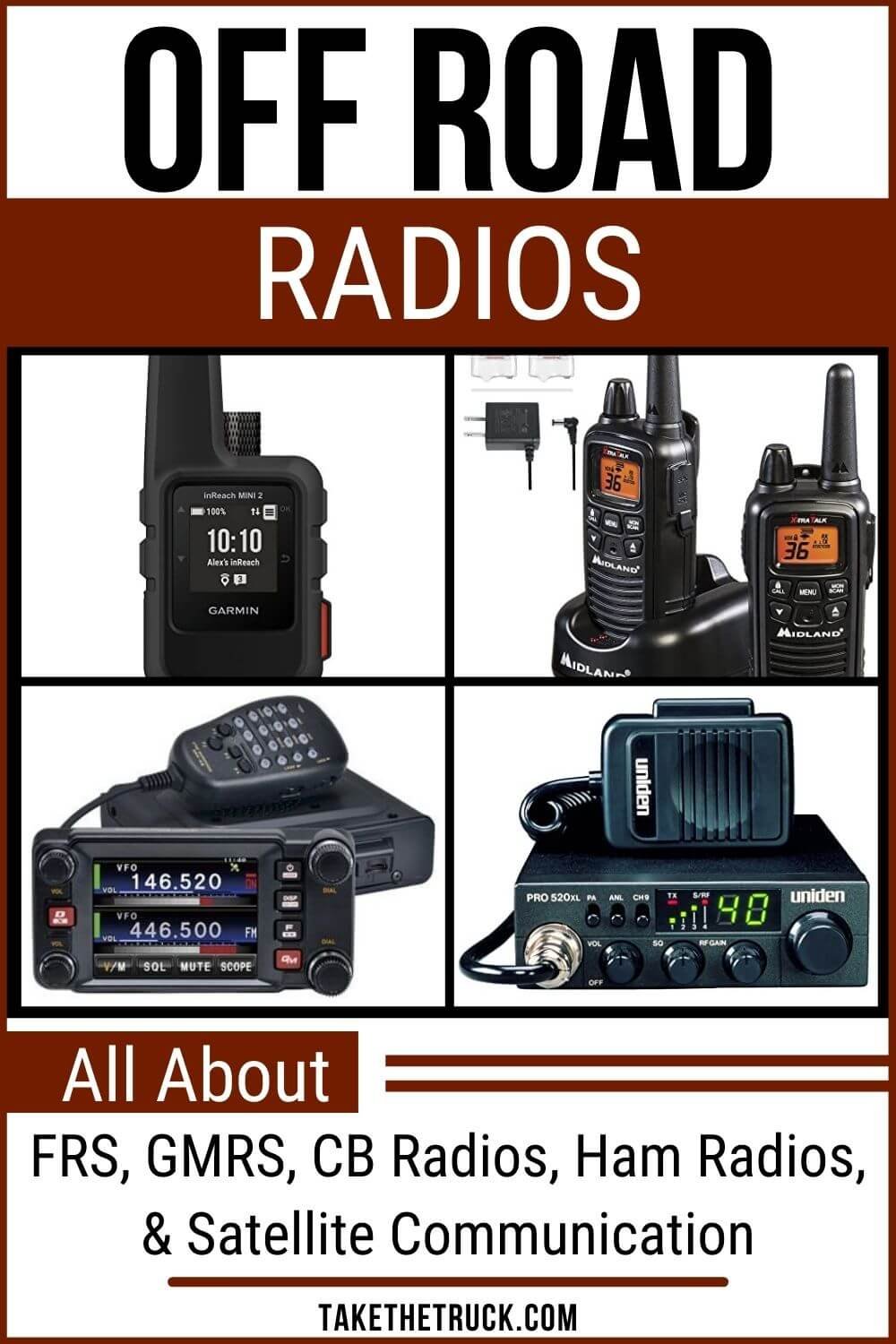Overlanding Off Road Radios and Emergency Communication Devices
If you’re looking for the best off road communication device for overlanding, camping, or off roading it can be difficult to know where to start and what type of emergency communication devices to bring on your adventures.
This guide will cover the basics of off road radios, overland radios, and emergency communication devices to help you select a good system, both for maintaining contact with your friends and family, as well as emergency services should the need arise.
*(This post contains affiliate links. This means we may receive a small commission, at no additional cost to you, if you make a purchase through a link. See our full disclosure.)
Overlanding Off Road Radio and Emergency Communication Device Types
There are six primary types of emergency communication devices that are used for communicating in the backcountry. These devices typically fall into one of two categories: short range and long range.
Below we’ll discuss the differences, advantages, and limitations of each category of emergency communication device, and provide some recommendations and tips to help you get the most out of your off road comms setup.
Short Range Communication Devices
Short range communication devices are used primarily in groups, whether it’s to stay in touch around camp, to communicate issues on the trail, or to notify someone close by in the event of an emergency. These overland and off road radios allow you to maintain contact with others in your party while out adventuring.
FRS Radios (Walkie Talkies)
FRS (Family Radio Service) radios, or walkie-talkies as they’re more commonly known, are short-range two way emergency communication devices that are cheap and easy to use. FRS radios require no testing or licensing to use and make a great back-up or spare off road communication tool to keep on hand for times when you’re out with others that do not have a more robust comms setup.
PROS
Low-cost
Easy-to-use
Highly Portable
No License Required
CONS
Limited Range (<30 miles, line-of-sight only)
Do not work well in dense tree cover or varied mountainous terrain
BEST FRS RADIOS FOR OFF ROAD, OVERLAND, AND EMERGENCY COMMUNICATION
Midland LXT600VP3 FRS Portable Two-Way Radios
Up to 30 mile range (unobstructed line-of-sight), 2-5 mile range (partially obstructed), <1 mile (heavily obstructed)
36 Channels
NOAA Weather Scan + Alerts
Motorola T402 Talkabout FRS Radios
Up to 35 mile range (unobstructed line-of-sight), 1-5 mile range (partially obstructed, <1 mile (heavily obstructed)
22 Channels
NOAA Weather Scan + Alerts
Built-in Flashlight
IP54 Weather Resistance
GMRS Radios
GMRS Radios are another short-range method of communicating off road or while overlanding in a group. They offer an extended range of communication, compared to FRS radios, with higher powered signal capability and a generally clearer signal. However, they do require a license to operate.
PROS
Low-cost
Highly Portable
If repeater capable, use of the GMRS repeater network can extend the usable range by “repeating” communications between GMRS radios even further
GMRS radios are becoming more commonplace in off roading circles (replacing the more traditional CB radios in group rides)
CONS
License Required (it’s easily obtainable for a small fee from the FCC)
Still Limited Range (sub 65 mile for mobile radios, sub 36 mile for handheld)
Signal quality is extremely dependent on line-of-sight between radios
Range is still greatly impacted by dense tree cover and other obstructions
BEST GMRS RADIOS FOR OFF ROAD, OVERLAND, AND EMERGENCY COMMUNICATION
Midland Handheld 50-Channel GMRS Radio
Range: 36 miles (unobstructed line-of-sight), 2-20 miles (partially obstructed), <1 mile (heavily obstructed)
50 channels
NOAA Weather Scan + Alerts
Midland MXT575 Mobile 50W GMRS Radio
Range: 75 miles (unobstructed), 20-25 miles (partially obstructed), <15 miles (heavily obstructed)
High 50W output greatly extends range/signal clarity
Repeater capable
Has narrow and wide-band selectability
CB Radios
CB (or Citizens Band) Radios have been a common off road and emergency communication device for decades and, despite their limited range and the growing popularity of GMRS radios, CBs are still the most commonly used short range radio - with some 30 million units in use by travelers, truck drivers, off roaders, and overlanders throughout the US.
PROS
Low-cost
Portable
Broadly Used
No License Required
CONS
Limited Range (<20 mile range for mobile radios, 3-15 miles for handhelds)
Signal quality is extremely dependent on line-of-sight
Range is still impacted by dense tree cover and other obstructions
BEST CB RADIOS FOR OFF ROAD, OVERLAND, AND EMERGENCY COMMUNICATION
Cobra HHRT50 Handheld CB Radio
4-Watt (legal max allowable) broadcast power
Mag Mount Mobile Antenna included
40 CB channels + 10 NOAA
Uniden PRO520XL Mobile CB Radio
4-watt broadcast power (can be “peaked and tuned” for extended range)
40 CB Channels
Built-in Speaker
Long Range Communication Devices
Long range communication devices can be used for both group communication and remote emergency communication needs. Unlike short range comms systems, these devices allow you to communicate over very long distances, even globally!
HAM Radios
Ham radios have been in use for nearly a century, and enable both short and long range communication using a variety of amateur radio frequencies and a vast amateur radio repeater network that spans the globe. Their range and versatility makes them excellent emergency communication devices and great comm devices for off roading and overlanding as well.
PROS
Exceptional Range
Not dependent on line-of-sight
Broadly used, with an extensive community of Amateur Radio Operators
No ongoing subscription or billing for service required (unlike the other long range communication devices)
Network is not as dependent on infrastructure - unlike cellular and satellite communication devices which depend on physical infrastructure, such as signal towers, to relay communications which can be impacted by severe weather events.
CONS
License is Required to Transmit Communication - there are three levels of HAM operator certification issued by the FCC - Tech, General, and Amateur Extra - that grant you access to and use of different amateur radio frequencies, and the testing can require a good deal of prep and studying
**Note that you do not need a license to own a ham radio, listen in, or transmit in the event of a critical emergency - but we highly recommend taking the time to get the license in order to get the full use and functionality out of your radio
Complexity - to setup and operate a HAM radio properly requires a bit of technical knowledge (thankfully there are vast amounts of materials, books, and fellow amature radio operators that can help)
Cost - high quality mobile ham radios and antenna can be pricey
BEST HAM RADIOS FOR OFF ROAD, OVERLAND, AND EMERGENCY COMMUNICATION
There are thousands of HAM radios on the market, but we recommend starting with a common dual-band 2m (144mhz-148mhz) / 70cm (420mhz-450mhz) unit which will provide decent stand-alone range and allow you to access repeaters for longer distance communication while off road, overlanding, or for emergency communication.
Yaesu FT-70DR 144/430mhz Handheld Ham Radio
Up to 40 mile stand-alone range
Rugged IP54 Dust/Water Protection
5W Transmit and wide-band receive
Yaesu System Fusion Compatible (increased digital communication capabilities)
Decent battery life for a handheld, but we recommend keeping extra batteries* on hand while traveling
Yaesu FTM-400XDR Mobile Ham Radio
Excellent built in GPS/APRS functionality - allowing you to transmit location information in real time as well as monitor others in your group (if they’re also equipped with a radio with this functionality)
50W Power provides excellent stand-alone range
Intuitive User Interface
Yaesu System Fusion & WiRES-X compatibility provide a wide array of advanced digital capabilities
Cellular Communication Devices
Cell phones are the most common communication device on the planet and, despite their sometimes limited coverage areas, their range and versatility typically make them a primary emergency communication device while off roading and overlanding.
PROS
You likely already have one!
Exceptional Range
Not dependent on line-of-sight
Extremely Multifunctional
CONS
Not as practical for group communication setups while off roading
Still suffer service coverage dead-zones making backup communication methods necessary**
Cost can be high for a quality device
Monthly service fees and/or contracts required
**UPDATE: With the release of the latest iteration of the iPhone 14, Emergency SOS satellite communication is now built-in and included for the first 2 years free-of-charge, making the iPhone 14 a viable all-in-one emergency communication device for off roading and overlanding!
TIPS FOR IMPROVING CELL PHONE USE FOR OFF ROAD, OVERLAND, AND EMERGENCY COMMUNICATION
Install a Cell Booster in your Vehicle
Our Camping Wifi Guide details our favorite service provider as well as the best cell booster we’ve found for working remotely and getting better cellular service in the backcountry
Use a Dual SIM cell phone
Dual SIM cell phones allow you to maintain your normal cell service in one sim card location, while adding a secondary sim card for local/regional service providers while you’re traveling abroad
Satellite Communication Devices
Satellite communication devices are arguably the most effective type of emergency communication device for off roading and overlanding. As long as you have clear visibility to the sky, you’ll be able to reach out for help.
And while satellite phones remain costly, there are some very cost-effective satellite communicators that allow you to send text and GPS location data to friends, loved ones, as well as emergency response personnel in the event help is needed.
PROS
Near Global Coverage
Not necessary to switch service providers while traveling globally
CONS
Not cost effective for group communication while off roading
Requires clear line-of-sight to the sky (may not work in areas of dense tree coverage)
Upfront device cost can be high
Monthly/annual service fees and/or contracts can also be costly depending on the network and service provider
BEST SATELLITE COMMUNICATION DEVICES FOR OFF ROAD, OVERLAND, AND EMERGENCY COMMUNICATION
BlueCosmo Inmarsat IsatPhone 2.1 Satellite Phone Kit
Inmarsat’s 3 Geostationary Satellite Network provides near global service coverage [no coverage at the northern & southern poles]
Generally lower cost than other satellite phone service providers, especially when paid annually
Built in GPS tracking and SOS beacon
Garmin InReach Mini 2 Satellite Communicator
Provides two-way text messaging using Iridium’s 60+ satellite network offering truly global coverage
Built in GPS tracking and SOS beacon
Lower monthly cost when compared to satellite phone service
Access to Garmin’s Earthmate cell phone app with an extensive catalog of downloadable maps
We personally find that a HAM radio, cell phone, and/or satellite communicator make a good flexible combination and allow for redundant means of emergency communication if needed. We hope this guide helps you select the right emergency communication device for your own off road and overland adventures.
If you have any questions or other emergency communication device recommendations, please drop a comment down below. And be sure to SUBSCRIBE for more helpful camping, overlanding, and family travel tips and guides.
As always, thanks for reading!
Related Posts:
Pin this Post!
We’d love a share! Thanks!














